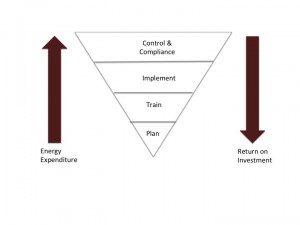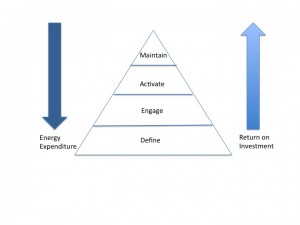The Paradox of Change Management
Save time and Resources: Build Readiness
(excerpt from Launch Lead Live: The Executive’s Guide to Preventing Resistance and Succeeding with Organizational Change)
Time is an issue in every organization. Initially, if you are used to working from a resistance perspective, it can feel like it takes longer to get people ready. It doesn’t. Consider the time and energy you must spend trying to enforce compliance when you use the traditional “resistance” approach.
By focusing on building readiness instead of managing resistance, and emphasizing the needs of the change-recipients, you can actually make better use of your time and resources. You can also get a greater return on your investment.
The traditional approach to organizational change (figure 1) looks to move quickly to training and implementation.

Figure 1 Common Approach to Organizational Change
Turner Change Management Inc.
It tries to minimize the amount of time spent in the early period; the majority of the effort is at the back end of the change. This approach gives the appearance of saving time, but it top loads issues so that they emerge right around the time of implementation– when time and resources are at a premium.
You expend more energy and resources, but the return on that energy decreases as people move through the Whitespace. It’s like heating your house in the winter while leaving the all the windows open.
This kind of back-end approach forces you to manage the resistance created when the change-recipients are pushed into taking action before they are ready. The approach gives the perception of speed, while actually taking more time. I call this the paradox of change management.

Figure 2 Change-Recipient Readiness Approach
Building readiness shifts the effort to the front end of the Event. Time is allocated to ensure the change-recipients can internalize the need, raise perceived capability, prepare, and support people through the transition. The change is built on a stable foundation. This results in a more sustainable change (Figure 2).
A Different Approach to New Year’s Resolutions
Happy New Year!
Have you made any New Year’s resolutions? I have. Research shows people who make New Year’s resolutions are 10 times more likely to meet their goals than people who don’t make resolutions.*
I used to write one or two goals statements because for me a New Year’s resolution was simply a goal I wanted to achieve for that year. Now I do it a little bit differently. Instead of writing one or two goal statements I think backwards and then create a four-word framework.
For several years I have been using a similar technique (the three words exercise) to help leaders understand the boundaries of the Whitespace when embarking on change. This (three-word) technique is a powerful tool for defining and understanding the full scope of any change initiative. However, until last year I had never thought about adapting the technique for my New Year’s Resolutions. The four-word framework provided a useful way of moving forward while accounting for the existing demands of my daily life and operational environment.
Using the framework gave me more flexibility. I was also able to respond better to new opportunities, and I could re-frame challenges more quickly to help me achieve my intended outcome.
One of the words in my 2015 framework was “learn”. The word represented professional and personal learning that I wanted to accomplish last year. It also guided the way I interacted with the world and reminded me to be open to new learning opportunities. I met my professional learning goals (e.g. WordPress), and opened up new learning opportunities for clients (e.g. The Executive Change Leader Course). I also learned in unexpected ways. For example, I learned and continue to learn different leadership skills as I work with a new (millennial) team member. I also learned more about writing, editing, and myself than I would have imagined when I published my first book.
Three Steps to Creating Your Four-Word New Year’s Resolution Framework
Just picking four words won’t give you a useful framework. Think about it like building a house, before you can frame the house you need to know what type of house you are building. Similarly, before you pick the four words that will define your framework you need an intended outcome. Here are three steps for using the four words technique to create or guide your New Year’s resolutions for 2016:
1. Allocate some time to reflect. Ask, What does your life look and feel like on December 31, 2016? Be clear, concrete, and concise. Write down your responses. This is your intended outcome.
2. Work backwards from your outcome. Keeping your outcome in mind, ask, what activities, behaviours or other aspects of my life are different in the outcome I envision from where I am today?
3. Choose four words that best represent, for you, your intended outcome. Write them down and keep them somewhere you can see them. (I keep mine posted above my keyboard).
Again this year, I have chosen four words that will provide the framework for my 2016 intended outcome. I am looking forward to filling in the framework and achieving my 2016 outcome.
Have you made any New Year’s Resolutions?
Wishing you success and happiness in 2016.
Dr. Dawn-Marie Turner
Helping you turn change from a liability to an asset.
Help! Our Change Champion Has Stopped Championing
What does a change management team do when the “champions” of the change stop championing?
A participant at a workshop asked me this question. The change management team was frustrated because the leaders who launched the change initiative had stopped championing it. Yet, they were still expected to implement the change.
I have been asked this or a similar question many times. The message I receive is always the same—the change management or project team feels abandoned by the change sponsor. Once this feeling emerges the team starts to question how they can successfully implement the change, or even why they should continue when it appears the change sponsor is not supporting the change.
When this happens both the specific change initiative, and your organization’s success with future changes is at risk.
Getting Leaders Ready: One key to successful organizational change
Summer is almost over and already you can see early signs that fall is on its way. The days are getting shorter, there is an evening chill that lingers a little longer in the morning and maybe the surest sign – the stores have begun to advertise their back to school specials.
As fall approaches and you get back into a more regular routine you may be thinking about rebooting and re-initiating work that you put off to let staff enjoy the summer or because you weren’t ready to get started. If any of that work involves change—whether it’s a software implementation, a new product launch, business expansion, new business process or any other type of change—it’s never too early to ensure your leaders and managers have the knowledge and skills to implement and sustain the changes your organization needs to be successful. Read more




